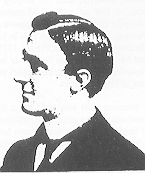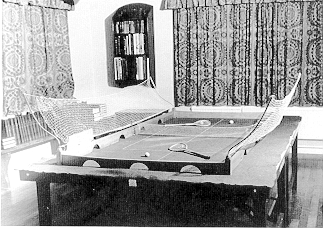|
"The game is simplicity itself.
lt ís playable on an ordinary dining-room table. It is lawn tennis in miniature, with a few modifications." So begins a short
article on table tennis in the New York Sun , March, 1902. The anonymous writer had probably just received from England
one of the earliest books on the 'new' game. He might have gone further to state - rather than merely to imply - that table
tennis is directly derived from lawn tennis which was itself derived from real tennis, the ancestor of all racket games. After
various abortive attempts to popularise forms of lawn tennis, including Major Wingfleld's 'Sphairistiké' which was produced
in 1874 as a new and improved portable court for playing the ancient game of tennis, the modem game of lawn tennis was finally
and firmly established with the first Wimbledon Championships in 1877.
The Honourable Ivor Montagu,
whose name will be seen to feature very prominently in this 'history', suggested that table tennis is "not so much a derivative
of lawn tennis as a collateral, born of the common parent, real or royal tennis, at about the same date." But he quoted no
evidence for this claim and it must be regarded as suspect.
What other possibilities are
there? Lawn tennis was designed, as its name suggests, as an outdoor game, and it was therefore very much subject to the vagaries
of English weather. Today we somehow have the impression, perhaps from contemporary illustrations of the garden scene, that
the sun always shone during Victorian summers. But no doubt there was sometimes a dash for cover and how then did the frustrated
lawn tennis players amuse themselves?
Commonsense suggests - and one
day, perhaps, it will be proved from private correspondence - that on such an occasion impromptu games of tennis were played
on a table, that is table tennis. This is certainly the earliest title for the game, not ping-pong as so commonly
supposed. Materials for play were readily to hand as all English households of any note, and certainly all those with a lawn
tennis court, had a dining-room and a large dining-table. Such accessories as rackets and a net could be conveniently improvisad
and a child's small rubber ball was most suitable for batting to and fro. In America
during the late 19th century, it is reported by Comelius G. Schaad in his book A Manual of Ping-Pong (1928) that an
indoor game based on lawn tennis was played with knitted balls so that damage to furniture was avoided.
Perhaps we should allow five
years from the first Wimbledon lawn tennis championships before this would come about. That
takes us to 1882 or thereabouts. Clearly we can never establish with any certainty when some informal version of the game
was first played and there is also the question of definition. A hand-coloured lithograph of about 1810 which shows how school
truants amused themselves in those days has a series of satirical scenes, one of which comprises some children playing with
a bat and ball on a rectangular piano top. No net is shown. Can this be regarded as a rudimentary version of table tennis?
Table tennis might, of course,
have been invented in another country. Andrea Franzoni, an Italian, said in his Storia degli Sport, 1936, that the
game was played - as a mere pastime - among Japanese nobility several centuries ago. But the Japanese do not seem to make
this claim, and it is almost certainly a confusion with the ancient game of battledore and shuttlecock which, however, does
not employ a table, a ball or a net. Moreover, Almqvist and Wiksell in their Sporten, Sweden, 1967, Bernard Le Roy
in his Dictionnaire des Sports, France, 1973, and Salvat in his Enciclopedia de los Deportes, Spain, 1976, all
support the idea of English origin.
Between 1901 and 1902 about fifteen
books on the game were published in England and the United States. Surprising as it may seem, no evidence has
yet been found of any publications in other countries during this period. Copies of most of these have now been traced - either
in the US Library of Congress or in private collections. Unfortunately, the copies held by the British Museum Library (now
the British Library) were destroyed by bombs during the Second World War. Several of these books have a section on the origins
of the game but the authors are lookíng back over twenty years or so and their references are often vague, speculative or
based on hearsay.

|
| Mr. Arnold Parker, the first Ping-Pong Association champion. Table Tennis and Pastimes Pioneer. |
Arnold Parker, the author of Ping-Pong,
the Game and How to Play It, 1902, and one of the earliest champions, gives 1881 as the first date he had heard in connection
with the game.He says that there was a rumour that someone in that year started to play with cigar-box lids for bats, champagne
corks (rounded one assumes) for balls and a row of books for a net. T'his is rather vague but he states more confidently that
the game really began about 1891 when a Mr. James Gibb persuaded John Jaques, the sports manufacturers, to register the title
´Gossima' for a version of the game which first of all used india-rubber balls until the introduction, about 1900, of celluloid
(or xylonite) balls. The much repeated story - which probably originates with Parker - tells how Gibb, a prominent athlete,
brought back some toy celluloid halls (sometimes said to be coloured) from the United States. Jaques soon saw how these
balls were a huge improvement on the small india-rubber balls previously used.
Much credit should be given to
Jaques for advancing the game in a general way far beyond mere commercial interest. The company had already promoted
croquet in a similar manner.
'Gossima' was certainly registered
(number 157615) on 16th July 1891, but not a single set seems to have survived and it must be doubted whether sets were ever
put into production
under this title. There is no
mention of the game in Cassell's Book of Sports and Pastimes, 1893. Sets with the title ´Gossima or Ping-Pong', dating
perhaps from the late 1890s, are known. A little later this was reduced to 'Ping-Pong', suggesting - by onomatopoeia the 'ping'
on the table and the 'pong' on the hollow vellum battledore. 'Gossima' presumably derived from 'gossamer', a garden cobweb,
and intended to convey the notion of 'lightness' associated with the game, was recognised by Jaques as unsatisfactory.
Also in 1902 M.J.G. Ritchie and
Walter Harrison published their Table Tennis and How to Play It. Ritchie, winner of lawn tennis championships in France,
Sweden, Denmark, Germany and Austria and runner-up in the Wimbledon Championships, took up the new game and was elected secretary
of the All- England Table Tennis and International Games Club. His coauthor was secretary of the first club ever formed -
the Cavendish - with its meeting-place at Armfield's Hotel, Finsbury, London. T'he authors, in a chapter 'The History of the Game'
confirm that "for its conception and origin we must undoubtedly look to the sister game, lawn tennis. Table tennis exhibits
nearly all the characteristics of the latter, and it is practically its replica in miniature." One of the authors had met
an individual (not named) who had played the game, under the title of table tennis, about 1890, the implements being
a table, net, book covers for rackets and a cork ball. Mr. R. S. Jones of St.John's College, Cambridge, and Leslie Jones were enthusiastic players and could probably be classed amongstthe
inventors of the original game.
Wooden rackets (to use the more
modern spelling) were soon adopted and rubber balls, but, as is well-known from other early references, these proved far too
lively in a confined space and caused too much damage in the cluttered Victorian dining-room.
Also, compared to lawn tennis,
the game lacked athleticism. For these reasons table tennis fell into obscurity until about 1900.

|

